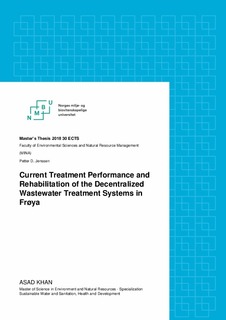| dc.description.abstract | Frøya Kommune is the westernmost and one of several coastal kommunes of the Fosen region in Trøndelag County, Norway. Frøya relies on the onsite facilities, mainly septic tanks, for the treatment of wastewater. Norwegian regulations allow direct discharge of septic tank effluent to the sea, but in Frøya there are many recreational and commercial interests as well as shallow zones that makes the sea a sensitive recipient. Thus, the wastewater treatment by these systems is inefficient in term of BOD, N and P because their treatment capacity is far lower than the commonly required/recommended of both Norwegian and European standards for wastewater water treatment. In addition most of the systems on the island are not properly handled and maintained. There are also some houses which discharge the water directly to the recipients and have no installed treatment facility. Data in WebGIS, a GIS-based registration and monitoring program especially designed for onsite systems, from Frøya Kommune has been used to estimate the total discharge and treatment of the pollutants by the onsite facilities in Frøya area. The collected data has been analyzed, the reasons of malfunction of these facilities and possible upgrading and rehabilitation are discussed in this report.
Based on the findings of this report, most of the facilities operational in Frøya are inefficient in term of BOD, nitrogen and phosphorus removal. They are categorized into different groups on the basis of the vulnerability of the recipients. Some of the systems need rehabilitation on urgent basis and others can be upgraded/replaced within the different deadlines set by the kommune on the basis of their vulnerability (within 3- 10 years). Some of the possible rehabilitation techniques are; the use of a biofilter coupled with filter of crushed local seashells and also a biochar filter, the use of source separation (this opens for biogas and fertilizer production or package treatment plants). | nb_NO |

